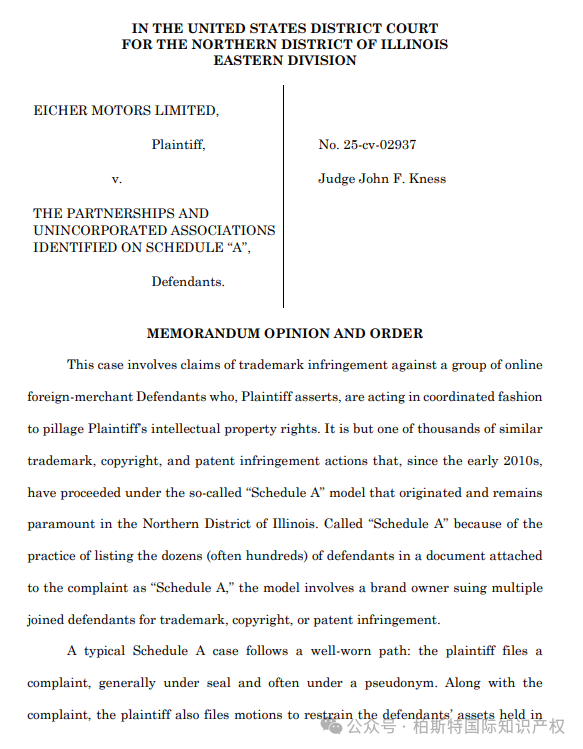- Knowledge
Preface:
On August 8, 2025, Judge John F. Kness of the Federal District Court for the Northern District of Illinois
In the case of Eicher Motors Limited v. Schedule A Defendant (case number 25-cv-02937), a landmark ruling was made to reject the plaintiff's application for a temporary restraining order (TRO) and systematically criticize the long-standing "Schedule A" bulk litigation mechanism. This ruling is seen as a judicial correction to the cross-border intellectual property rights protection model, and may reshape the pattern of e-commerce infringement litigation in the United States.

1、 Core points of the ruling: The seven crimes of Schedule A mechanism
Judge Kness pointed out the systemic flaws of this litigation model in a 24 page memorandum of opinion
1. The inversion of procedural justice
The court emphasized that according to Rule 65 (b) of the Federal Rules of Civil Procedure, a unilateral TRO must meet the strict standard of "specific facts proving that failure to provide immediate relief will result in irreparable harm" and should notify the defendant as much as possible. However, in Schedule A cases, there is a common practice of "freezing funds first and notifying the defendant later", which essentially "reverses the burden of proof for procedural justice".
2. The proliferation of template based lawsuits
The judge cited scholars' research and pointed out that the plaintiff's lawyer used a "factory mold style" template to file a lawsuit, only replacing the defendant's name and product screenshots, lacking a specific description of the infringement facts for a single defendant. This' one size fits all 'lawsuit has been criticized as an' abuse of judicial resources'.
3. The fragility of the evidence chain
Most cases rely solely on screenshots from e-commerce platforms to accuse infringement, without providing physical product comparisons. The judge questioned, "How to determine whether a product constitutes trademark infringement through screenshots? The defendant may hold legal authorization, but the court has no way of knowing in the unilateral procedure
4. The coercive nature of asset freezing
Data shows that over 90% of cases end with the defendant paying settlement money in exchange for account unfreezing, rather than a court ruling. The ruling states that "asset freezing has become a tool for forcing reconciliation, rather than a legitimate means of protecting intellectual property rights
5. The arbitrariness of the defendant's merger
The court cited the Estee Lauder case (334 F.R.D. 182) and pointed out that merging dozens of unrelated cross-border e-commerce sellers for trial violates the merger standard of "the same transaction or event" under Rule 20 (a) (2) of the Federal Rules of Civil Procedure.
6. Lack of judicial transparency
The judge particularly criticized the widespread phenomenon of document sealing: "If the purpose of safeguarding rights is to stop infringement, secret litigation will actually weaken the actual effectiveness of the injunction
7. Overdraft of judicial authority
TRO was supposed to be an "exceptional remedy in extreme circumstances," but in recent years, the Northern District Court of Illinois has approved over 20 Schedule A cases per day, making "unconventional remedies a routine operation.
2、 Judicial shift: from "batch release" to comprehensive review
Judge Kness took three groundbreaking measures:
1. Suspension mechanism for the entire institution
Prior to the ruling, all new Schedule A cases within the jurisdiction have been suspended from trial, and the plaintiff is required to provide specific factual explanations.
2. Reconstruction of Evidence Standards
It is explicitly required that substantive evidence such as physical product comparison and individual defendant infringement analysis must be provided in future cases.
3. Strengthening procedural justice
It is prohibited to freeze assets without notifying the defendant, unless it is proven to be an emergency situation where a specific defendant has started transferring assets.
This position has received a response from the academic community. Professor Eric Goldman from Santa Clara University Law School commented, "This ruling marks the beginning of the judicial system's efforts to repair the distorted ecosystem of rights protection
3、 Industry impact and compliance insights
The impact on cross-border sellers
Reduced cost of rights protection: The defendant can use this precedent to defend against TRO applications with insufficient evidence, question the legality of TRO, and be forced to end the era of settlement;
Expanded defense space: Courts tend to require plaintiffs to provide specific proof of infringement rather than relying on presumptions.
Suggestions for rights holders
Evidence collection: Independent evidence collection is required for each defendant, including mystery shopping, product appraisal, etc.
Litigation strategy: Avoid "casting a wide net" lawsuits and shift towards precise targeting of malicious infringers.
Platform compliance warning
E-commerce platforms may adjust their account freeze policies and require higher standards of infringement notifications.
Suggest establishing a balance mechanism of "infringement complaints seller appeals platform rulings".
4、 Future prospects: the starting point of institutional reform
This ruling forms a precedent chain with recent cases such as Zorro (2023 WL 8807254) and Estee Lauder, reflecting the collective reflection of the judicial system on the Schedule A mechanism. As Judge Kness said, "The severity of intellectual property infringement cannot be a reason for distorting procedural rules." Future reforms may involve:
The Federal Judicial Council formulates Schedule A case trial guidelines
Congress revises the Lanham Act to clarify cross-border infringement evidence collection standards
Rebalance of Responsibilities between E-commerce Platforms and Rights Holders
This judicial correction will continue to affect the business strategies of tens of thousands of cross-border merchants, and its far-reaching impact is no less than the industry reshuffle triggered by the "Balance Car Patent War" in 2016.




